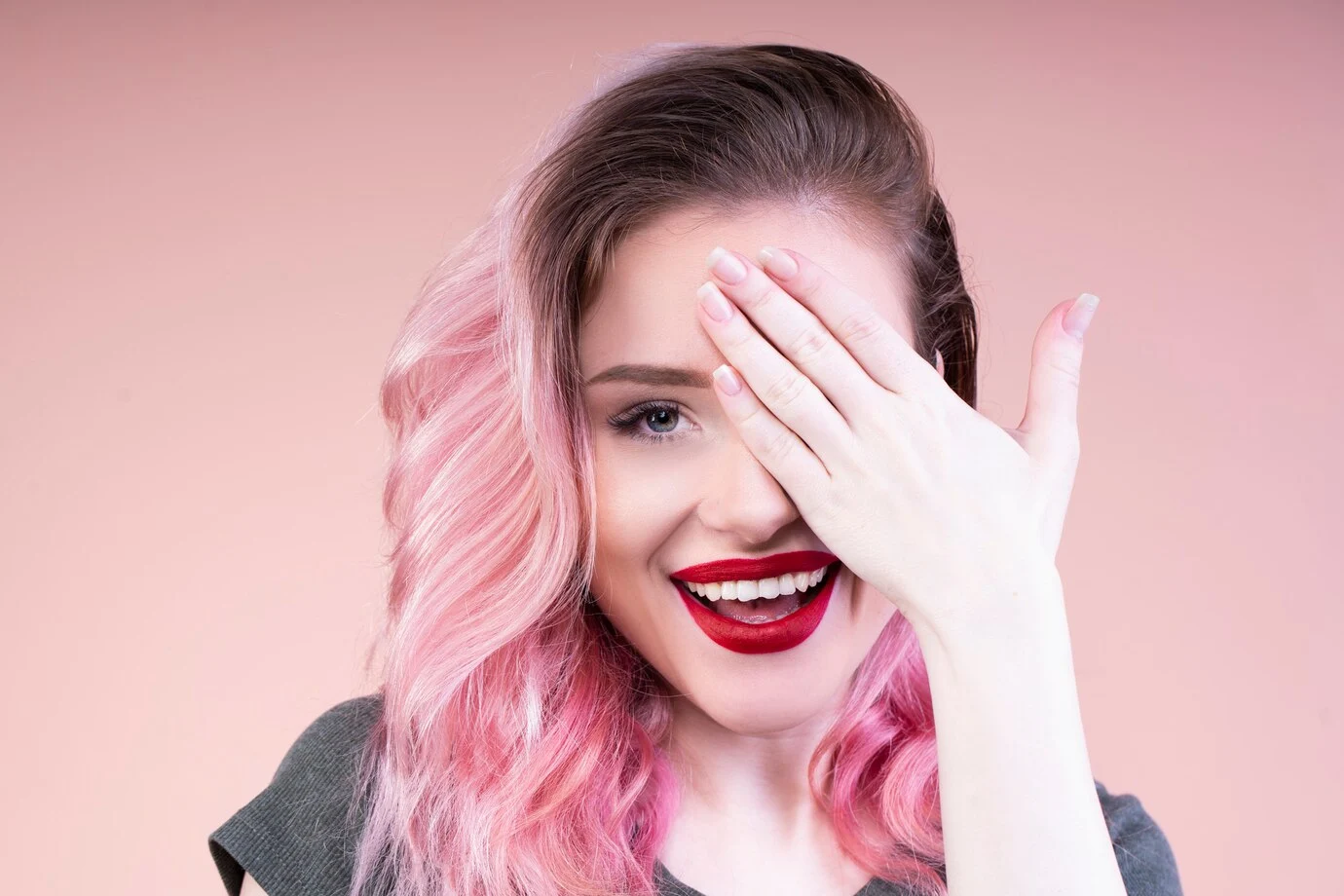Pink hair is bold, fun, and expressive—but what happens when you’re ready for a change? Whether you’re transitioning back to your natural color or trying something new, removing pink dye from your hair can feel like a daunting task. The good news? With the right approach, it’s entirely possible to say goodbye to pink without sacrificing your hair’s health. This guide will walk you through everything you need to know, from gentle fading methods to professional solutions, along with expert tips and personal anecdotes to make the process easier.
Understanding the Type of Dye
Before diving into removal methods, it’s crucial to understand the type of dye you’re dealing with. Pink hair dye typically falls into two categories:
- Semi-Permanent Dye: This type of dye coats the outside of the hair shaft and fades over time. It’s easier to remove and responds well to gentle treatments.
- Permanent Dye: Permanent dye penetrates the hair shaft, making it more stubborn to remove. This type often requires stronger methods or professional help.
Knowing which type of dye you used will help you choose the most effective removal strategy.
Here’s a table summarizing the key points about removing pink dye from hair, making it easy for readers to understand the methods, pros, and cons:
| Method | Best For | How It Works | Pros | Cons |
|---|---|---|---|---|
| Clarifying Shampoo | Semi-permanent dye | Strips away dye buildup with frequent use. | Gentle; easy to use at home. | Requires multiple applications. |
| Vitamin C Treatment | Semi-permanent dye | Crushed vitamin C mixed with shampoo lifts dye molecules. | Affordable; minimal damage. | Can be drying; may require multiple uses. |
| Baking Soda + Shampoo | Semi-permanent dye | Baking soda exfoliates and lifts dye from hair. | Natural; effective for light fading. | Drying; not suitable for frequent use. |
| Color-Stripping Products | Stubborn or permanent dye | Shrinks dye molecules for easier removal. | Effective for tough dyes. | Harsh on hair; may require deep conditioning. |
| Bleaching | Permanent dye or lightening | Lifts color from hair shafts. | Highly effective for lightening. | Can cause significant damage; best done by a professional. |
| Professional Color Correction | All dye types | Customized approach using salon-grade products. | Safe; tailored to your hair’s needs. | Expensive; requires a salon visit. |
Post-Removal Hair Care Tips
| Step | Why It’s Important |
|---|---|
| Deep Conditioning | Restores moisture and repairs damage caused by dye removal. |
| Avoid Heat Styling | Prevents further damage to already stressed hair. |
| Trim Damaged Ends | Removes split ends and promotes healthier hair growth. |
| Use Heat Protectant | Protects hair if heat styling is necessary. |
| Limit Washing | Reduces stripping of natural oils; use dry shampoo between washes if needed. |
Comparison: DIY vs. Professional Methods
| Factor | DIY Methods | Professional Methods |
|---|---|---|
| Cost | Affordable; uses household or store-bought products. | More expensive; requires salon services. |
| Effectiveness | Works well for semi-permanent dye; may require multiple attempts. | Highly effective for all dye types; tailored to your hair’s needs. |
| Hair Health | Can be drying or damaging if not done carefully. | Minimizes damage with professional-grade products and expertise. |
| Time | Gradual process; may take weeks to see results. | Faster results, often in a single session. |
Quick Tips for Removing Pink Dye
| Tip | Why It’s Important |
|---|---|
| Patch Test | Ensures you don’t have an adverse reaction to products. |
| Be Patient | Gradual methods are gentler on your hair. |
| Consult a Professional | For stubborn or permanent dye, professional help ensures better results. |
| Prioritize Hair Health | Focus on deep conditioning and avoiding heat to maintain hair integrity. |
This table format provides a clear, easy-to-understand breakdown of the methods, pros, and cons of removing pink dye from hair. It also includes post-removal care tips and a comparison of DIY vs. professional methods, helping readers make informed decisions.
Gentle Methods for Fading Pink Dye
If you’re dealing with semi-permanent pink dye, there are several gentle methods to help fade the color over time. These approaches are less damaging and can be done at home.
1. Clarifying Shampoos
Clarifying shampoos are designed to remove product buildup and can help strip away semi-permanent dye. Use a clarifying shampoo every few washes to gradually fade the pink color.
Pro Tip: Look for shampoos with sulfates, as they are more effective at breaking down dye molecules.
2. Vitamin C Treatment
Vitamin C treatments are a popular DIY method for fading hair color. Here’s how to do it:
- Crush 10–15 vitamin C tablets into a fine powder.
- Mix the powder with a small amount of clarifying shampoo to create a paste.
- Apply the mixture to damp hair, focusing on the pink areas.
- Cover your hair with a shower cap and leave the treatment on for 1–2 hours.
- Rinse thoroughly and follow up with a deep conditioner.
Personal Anecdote: When I wanted to fade my pastel pink hair, I tried the vitamin C method. After two treatments, the color had noticeably lightened, and my hair felt surprisingly soft!
3. Baking Soda and Anti-Dandruff Shampoo
Baking soda is a natural exfoliant that can help lift dye from your hair. Mix equal parts baking soda and anti-dandruff shampoo, apply it to your hair, and leave it on for 20–30 minutes before rinsing.
Caution: This method can be drying, so be sure to follow up with a hydrating hair mask.
Stronger Methods for Stubborn Dye
If gentle methods aren’t cutting it, you may need to try stronger techniques. These methods are more effective but can be harsher on your hair, so proceed with caution.
1. Color-Stripping Products
Color-stripping products, like Color Oops or One ‘n Only Colorfix, are designed to remove artificial dye from hair. These products work by shrinking the dye molecules, allowing them to be washed out.
How to Use:
- Follow the instructions on the product carefully.
- Perform a patch test to avoid adverse reactions.
- Be prepared for multiple applications if the dye is particularly stubborn.
Expert Insight: Michelle Lee, a hairstylist, advises, “Color-stripping products can be effective but should be used with caution. They can be drying, so deep conditioning afterward is a must.”
2. Bleaching
Bleaching is a more aggressive method that can effectively remove pink dye, especially if you’re aiming for a lighter color. However, bleaching can damage your hair, so it’s best to consult a professional.
Pro Tip: If you decide to bleach at home, use a low-volume developer (10 or 20 volume) to minimize damage.
Personal Anecdote: My friend Sarah tried bleaching her pink hair at home and ended up with uneven results. She eventually visited a salon, where a stylist corrected the color and restored her hair’s health. Lesson learned: sometimes, it’s worth leaving it to the pros!
Professional Solutions
If DIY methods aren’t working or you’re dealing with permanent dye, it’s time to consult a professional. Hairstylists have access to stronger products and techniques that can safely remove pink dye without compromising your hair’s health.
1. Color Correction
Color correction is a specialized service offered by many salons. A stylist will assess your hair’s condition and use a combination of color removers, toners, and treatments to achieve your desired result.
Expert Insight: Sal Salcedo, a hairstylist, emphasizes, “Color correction requires expertise. A professional can tailor the process to your hair’s needs, ensuring the best outcome.”
2. Olaplex Treatments
Olaplex is a bond-building treatment that repairs damage caused by chemical processes like bleaching and dyeing. Many salons offer Olaplex as part of their color correction services to keep your hair healthy during the removal process.
Post-Removal Hair Care
Removing pink dye can take a toll on your hair, so it’s essential to focus on restoring its health afterward.
1. Deep Conditioning Treatments
Use a deep conditioning mask at least once a week to replenish moisture and repair damage. Look for products containing ingredients like keratin, argan oil, and shea butter.
2. Avoid Heat Styling
Give your hair a break from heat styling tools like flat irons and curling wands. If you must use them, always apply a heat protectant.
3. Trim Damaged Ends
If your hair feels dry or brittle after dye removal, consider getting a trim to remove split ends and promote healthy growth.
Personal Anecdotes and Tips
Jane’s Story: From Pink to Platinum
Jane, a college student, decided to transition from bright pink to platinum blonde. She started with clarifying shampoos and vitamin C treatments, which faded the pink significantly. However, some stubborn patches remained, so she consulted a professional. The stylist recommended a gentle bleach bath, which successfully lifted the remaining color. Jane followed up with weekly deep conditioning treatments, and within a month, her hair was healthy and ready for her next color adventure.
Emma’s Experience: The Power of Patience
Emma loved her pink hair but needed a change for a new job. She opted for the gradual fading method, using clarifying shampoos and regular vitamin C treatments. Over several weeks, the pink faded to a soft pastel, which she then covered with a darker, natural shade. Emma’s patience paid off, as her hair remained healthy throughout the process.
Expert Insights and Studies
Understanding the science behind hair color removal can help you make informed decisions. Here are some key insights:
- “The Effectiveness of Different Hair Color Stripping Products” (International Journal of Trichology): This study compares the effectiveness of various hair color stripping products, helping you choose the right approach for removing pink dye.
- “The Impact of Hair Color Removal on Hair Health” (Journal of Cosmetic Science): This research explores the potential damage caused by hair color removal processes, emphasizing the importance of post-removal care.
- “The Role of Hair Salons in Color Correction and Hair Repair” (Journal of Cosmetology Science): This study highlights the expertise of hair salons in correcting color mistakes and repairing hair damage.
Final Thoughts
Removing pink dye from your hair can be a journey, but with the right methods and a focus on hair health, you can achieve your desired results. Whether you choose gentle fading techniques or stronger removal methods, remember to consult professionals when necessary and prioritize deep conditioning to keep your hair in the best possible condition.
Patience and consistency will be your best friends in this process, and soon enough, you’ll be ready for your next hair color adventure.
Key Takeaways:
- Understand the type of dye (semi-permanent vs. permanent) before choosing a removal method.
- Gentle methods like clarifying shampoos and vitamin C treatments work well for semi-permanent dye.
- Stronger methods, such as color-stripping products or bleaching, may be necessary for stubborn dye.
- Consult a professional for color correction or if you’re unsure about DIY methods.
- Focus on deep conditioning and hair care to restore health after dye removal.
With this guide, you’re equipped to tackle pink dye removal like a pro. Happy hair transformation!
Read More About Pink Hair Dye Articles
For more information on related topics, check out our detailed guides:
-
-
How to Remove Pink Hair Dye and Achieve Your Dream Hair Color
-
Is Stripping Pink Dye Right for You? A Guide to Weighing Your Options
-
Hot Pink Hair for Every Hairstyle: From Short Cuts to Long Locks
-
Pink Hair on Dark Hair? Can You Dye Dark Hair Pink Without Bleaching?
-
Pink Hair Dreams? Is Pink Dye Right for You? A Beginner’s Guide




